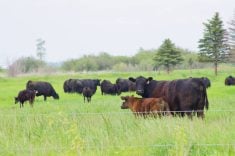A calf persistently infected with bovine viral diarrhea can cost a producer $20 per cow per year, says a Pfizer Animal Health veterinarian.
BVD and infectious bovine rhinotracheitis, or IBR, are two troublesome diseases that can be controlled with a diligent vaccination program, said Les Byers.
Immunization offers fetal protection, stops the disease cycle and prevents reproductive losses.
Byers recommended live modified vaccines because protection lasts longer, although it is important for producers to consult with their veterinarians on what will work best within their management program.
Read Also

House ag committee to undertake several studies
The House of Commons standing agriculture committee has set its agenda for the coming months. Members began the fall sitting with a two-hour update on international trade
“We feel we get the best protection if we use a modified live vaccine that contains IBR and BVD Type I and Type II fetal protection type vaccine,” he said.
IBR causes respiratory disease and may cause abortion in pregnant cows at any time during pregnancy. In susceptible herds an abortion storm may result in half the cows losing calves. Normal abortion losses are one to two percent.
BVD is also linked to respiratory disease and studies have shown as many as 25 percent of feedlot deaths are due to this infection. The disease cripples the animal’s immune system, making it susceptible to a range of infections and disease.
It is especially serious when it infects a fetus in a susceptible cow that is 50 to 120 days pregnant. It may cause abortion, stillborn calves and the birth of persistently infected calves. These continue to infect others, turning the problem of BVD into a vicious cycle, Byers said.
A persistently infected calf may appear normal but sheds virus particles in its body fluids. The calves can re-infect their mothers and other cows that are bred in the same pastures.
“If you’ve got BVD virus floating around your newborn baby calves this time of year, you are going to see all kinds of sickness because of the immunosuppression,” he said.
Infected feedlot calves can become an expensive proposition. Producers will see more scours than normal, more pneumonia, more naval infections, reduced fertility and poor weight gain.
“It is a nasty disease for the cow-calf guy as well as it is a nasty disease for the feedlot,” Byers said.
“Both groups would benefit if we could get rid of those PI (persistently infected) animals.”
Pfizer and another company offer a modified live vaccine product that can be given to pregnant cows for protection. Once vaccinated the cow is able to neutralize the virus before it reaches the fetus.
Byers recommended starting cows on a pre-breeding program at least two weeks before vaccinating.
“I would prefer to see people out at around four weeks pre-breeding. Once they are on a program it is safe to go back into those pregnant cows and use the product on the pregnant cow.”
It is important to read drug labels and consult with local veterinarians to find out which product fits best. Products without fetal protection claims may not be safe for pregnant cows or calves nursing pregnant cows. It is not a fetal protection vaccine unless the label says so.
Scientists are aware of a number of strains with varying degrees of virulence, but many vaccines provide good cross protection.
“The vaccines will protect certainly against a number of different strains out there,” he said.
No vaccination is perfect but modern drugs are proving to be effective.
A troublesome aspect of this disease is that it may take a laboratory analysis to determine its presence because other infections and nutritional problems can lead to the same conditions.
A producer should become suspicious if he sees more dead animals than normal as well as chronic animals requiring multiple treatments, poor gainers or runty animals.
Aborted fetuses are contaminated with virus but do not look different and would have to be tested for the cause of death.
“You are not going to find BVD unless you look for it because the clinical signs are not very overt,” Byers said.
The lab looks for the virus in the tissue or blood. Tissue samples may be a skin biopsy or ear notch. When subjected to immunohistochemistry, the virus is easily identified. Results take three to seven days.
BVD was first diagnosed in 1946 and probably arose from a virus mutation. In the last 60 years scientists have developed an extensive file but know there is considerably more to learn about the disease, Byers said.

















